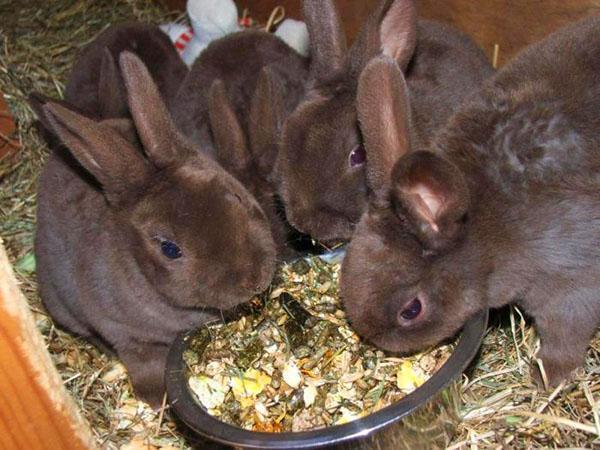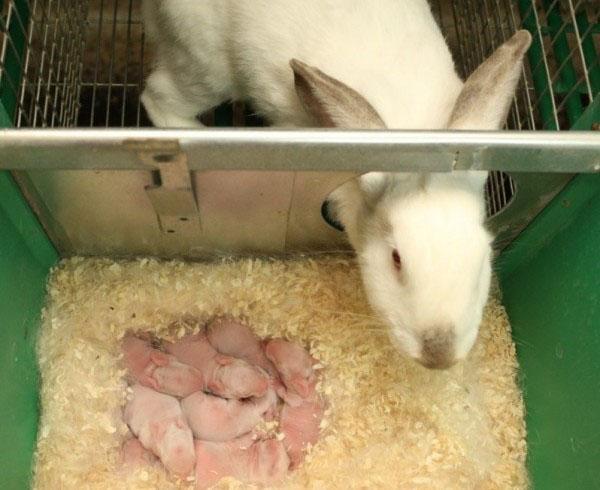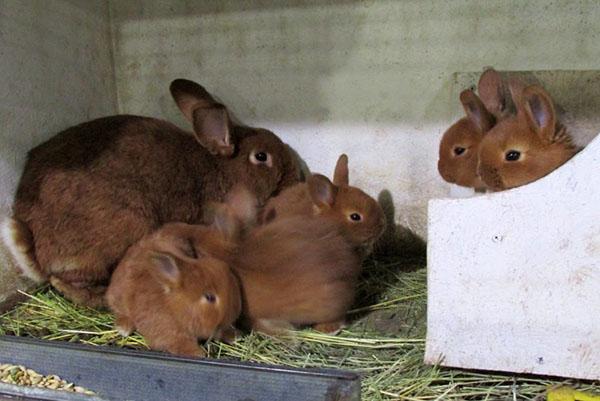When to remove bunnies from a bunny - tips for beginners
 Novice breeders in the process of work are faced with many questions and ambiguities. Wanting to get the maximum offspring from the female, you need to know how and when to remove the rabbits from the rabbit so as not to harm the growing pets. Rabbits are planted in different ways. It all depends on the technique of raising rabbits.
Novice breeders in the process of work are faced with many questions and ambiguities. Wanting to get the maximum offspring from the female, you need to know how and when to remove the rabbits from the rabbit so as not to harm the growing pets. Rabbits are planted in different ways. It all depends on the technique of raising rabbits.
Read also the article: what to feed rabbits in autumn and winter?
The two most commonly used methods of raising rabbits are:
- 28 day weaning of litter from mother.
- Departure for 35-40 days.
- Weaning in 40-45 days.
- 56 or 60-day weaning of young animals from the mother.
Departure on day 28

And although newborn rabbits are naked and blind, but already on the 17-20th day, the rabbits are already trying plant food. Lactation lasts about 12 weeks in females. That is why it is necessary to take care of soft food in the female's feeders. This is due to the fact that when the rabbits begin to leave the nest, they, imitating their mother, will eat from the feeder. Until the same time, they feed exclusively on milk. And at thirty days, the stomach enzymes have not yet begun to function normally. This is why weaning babies at this age is not recommended. There are also large metabolic costs in females.
On the 24-day day of life, the body of the rabbits is already only 50% dependent on the milk of the rabbit. On day 35, the rabbit depends on only 5-8% of the rabbit's milk.
Weaning in 35-40 days
 If planted on the 35-40th day, then there are not so many advantages for such rabbits over the 28-day-old weaned rabbit.
If planted on the 35-40th day, then there are not so many advantages for such rabbits over the 28-day-old weaned rabbit.
First, care must be taken to ensure that 35-day-old rabbits do not overeat on the following days. Otherwise there will be an upset in their stomachs and diarrhea will appear. Consequently, the next portion of feed is given after eating the entire previous one.
Secondly, the female is covered after 10-20 days. The later, the more she will rest from the weaned rabbits.
Weaning at 40-45 days
 Regardless of the timing of weaning, in the weaned young in the first 10 days, the acidity in the stomach is greatly reduced. This is due to a decrease in the strength of the juice and the development of catarrhal phenomena in the digestive tract of young animals, which are just getting used to roughage.
Regardless of the timing of weaning, in the weaned young in the first 10 days, the acidity in the stomach is greatly reduced. This is due to a decrease in the strength of the juice and the development of catarrhal phenomena in the digestive tract of young animals, which are just getting used to roughage.
This is why the best weaning period is 40-45 days. Rabbits use vegetable and other foods better. First, they give food such that their mothers fed them in the last time before jigging. Transfer to new feed gradually. This is especially true for green food.
It is especially necessary to treat rabbits carefully in the first 1.5-2.5 months after separation from the mother.
Broiler rearing
 When can you put the rabbits from the rabbit for meat?
When can you put the rabbits from the rabbit for meat?
Broiler jigging of rabbits is done on 56-60 days. In such cases, they are immediately slaughtered at weaning. You can also grow another 15-20 days before slaughter on protein-rich forage.
 This kind of raising rabbits at home is most suitable for meat breeds of rabbits. For example, for a Californian breed or a French ram. It has been noticed by breeders that such carcasses contain more protein and fat compared to rabbits of 4 months of age, which were raised by conventional methods. This is due to the fact that when the rabbits are removed from the rabbits at this age, it increases the protein content in the body of newborn rabbits.
This kind of raising rabbits at home is most suitable for meat breeds of rabbits. For example, for a Californian breed or a French ram. It has been noticed by breeders that such carcasses contain more protein and fat compared to rabbits of 4 months of age, which were raised by conventional methods. This is due to the fact that when the rabbits are removed from the rabbits at this age, it increases the protein content in the body of newborn rabbits.
Jigging methods
Jigging is done in the following ways:
- they immediately jig the entire offspring;
- the separated rabbits are periodically admitted to the rabbit for several days;
- first, strong rabbits are separated from the rabbit, and when 2-3 days have passed, the weak are taken away, and the more frail rabbits are kept with their mother and longer.
 The third option is beneficial when there is abundant milk production in the females. The cubs remaining from the litter have more time to suckle the mother and, due to this, are compared with the first in development. Strong rabbits, which were taken away first, are left to the tribe in the future, and the latter are slaughtered for meat.
The third option is beneficial when there is abundant milk production in the females. The cubs remaining from the litter have more time to suckle the mother and, due to this, are compared with the first in development. Strong rabbits, which were taken away first, are left to the tribe in the future, and the latter are slaughtered for meat.
Equality of development of rabbits, from one litter, by weight is an excellent sign of uniformity of all mammary glands in a female. Therefore, if the offspring is different in height, it means that the weaker ones are deposited later and, if necessary, are periodically admitted to the mother.
What do they do when jigging?
Putting the young rabbits away from the rabbits, the babies are weighed. Then they are divided into groups by weight and gender. With this sorting of rabbits, it will be possible to raise them all.
 Cells for jigging there are 3-5 heads. Less often by 7. Can be transplanted into group cages-aviaries for 10-15 rabbits. It is not recommended to plant offspring from different litters in one cage. If this cannot be avoided, then replanting from other offspring is done in an unknown cage for both broods. If there are fights, then the fighters are seated one by one.
Cells for jigging there are 3-5 heads. Less often by 7. Can be transplanted into group cages-aviaries for 10-15 rabbits. It is not recommended to plant offspring from different litters in one cage. If this cannot be avoided, then replanting from other offspring is done in an unknown cage for both broods. If there are fights, then the fighters are seated one by one.
In the third month, breeding males are seated one per cage, breeding females - 2-3. All others are planted in 6-8 cages and 2 in cages for the base herd.
So, the question: "When to remove the rabbit from the rabbit?", Has several answers.
Let's briefly summarize them:
- On day 28, weaning is done only if the female was covered by the male the next day after birth.
- On 35-40 days youngsters are planted for more frequent obtaining of offspring from producers.
- At 40-45 days, weaning is most beneficial. Since the rabbits have gained immunity from the mother and will more easily tolerate the transition to roughage.
- Broiler placement at 56 or 60 days old gives a large weight gain in young rabbits. If necessary, you can increase the mass of young animals with compound feed for 15-20 days.
Therefore, it is up to you at what age the rabbits are separated from the rabbits and for what needs.